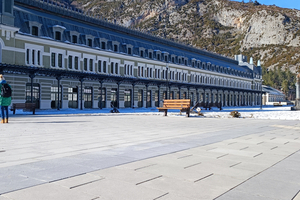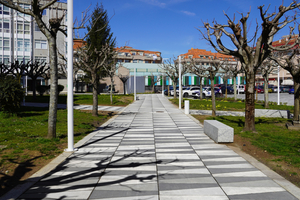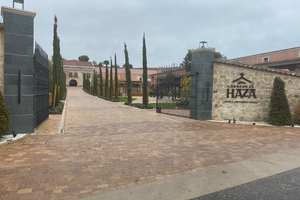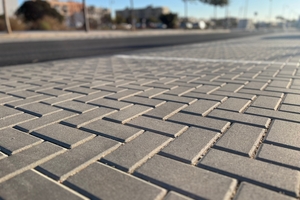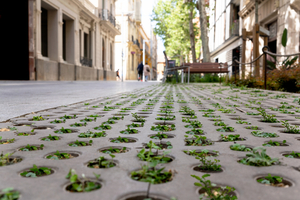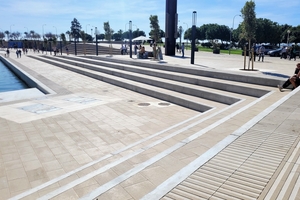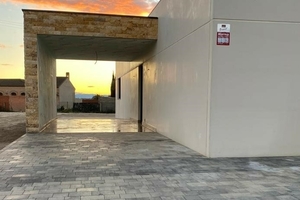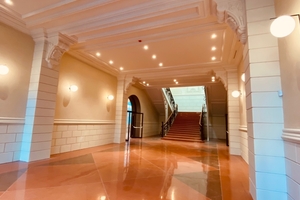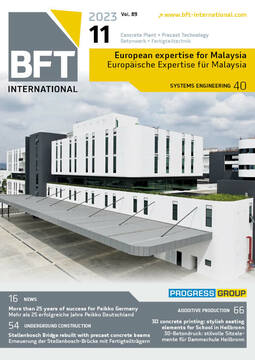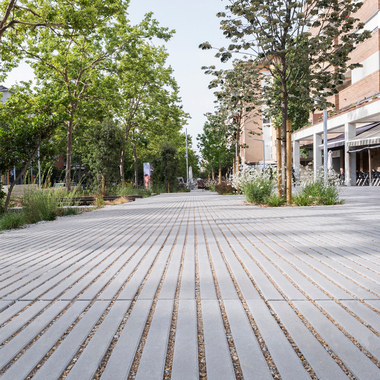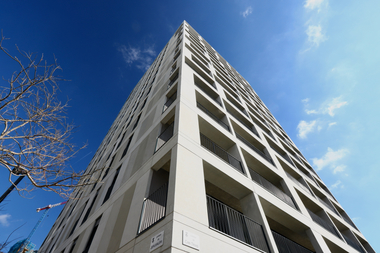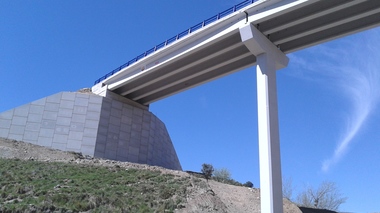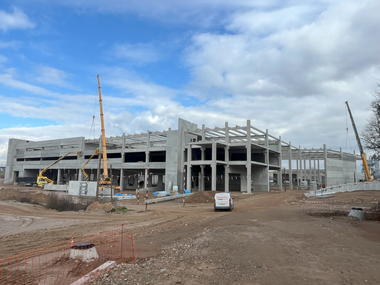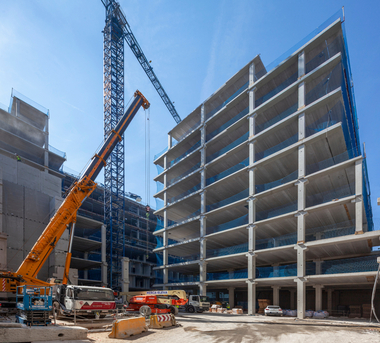Projects and buildings with concrete goods implemented in Spain 2023: urban spaces
The Spanish concrete association ANDECE regularly presents to its member companies new reference projects with precast concrete elements. The contribution in this issue features examples from recent months that feature concrete paving blocks and tiles from the garden and landscaping sector.
The first issue of this year focused on projects and buildings whose façades are distinguished by the characteristic features of precast elements [1]. In the current magazine issue, the focus shifts from the building envelope to various solutions for road surfaces in public spaces. Over the past decades, precast elements have undoubtedly been the predominant construction material in the design of public spaces. There is every expectation that their future is even more promising when digitalization and the inevitable decarbonation of the construction processes [2] prevail on the market.
The fact that precast elements are extremely versatile both in regard to their geometry and to their surface treatment, as well as their possible applications, confirm this prediction. But this is not the only area of the precast industry that attests to the unlimited applications that are available. Every single manufacturer expands the extremely diverse range of concrete elements. Serial manufacture of structural components and precast elements from catalogs, as well as specific elements adapted to respective projects, are frequently offered together. In the following, we would like to present to you some of the most outstanding projects implemented in recent months by members of the Spanish concrete association ANDECE [3].
1 Paving and rehabilitation of the intermodal railroad station in Canfranc, (Huesca) with concrete slabs from PREFABRICADOS PUJOL
The emblematic railroad station of Canfranc on the fringes of the Pyrenees in the region of Aragon in Spain was inaugurated in 1928 and developed in the course of time into the second-largest railroad station in Europe. This railroad line was the most important link between Spain and the rest of Europe. It speeded communication and the movement of goods until, in 1970, the bridge of L’Estanguet collapsed and traffic on the international line had to be discontinued. After the collapse, the railroad station and the related facilities were shut down. After many years of calls for reopening, the rehabilitated railroad station now has a future full of opportunities.
In 2022, with a view of resuming international train service, the new railroad station and the train depot were put into operation. The Spanish authorities for administering the railroad infrastructure, ADIF, and the government of Aragon agreed to reserve an area of 67,023 m2 for the railway network and 131,906 m2 for urban purposes and to build a new railroad station.
Prefabricados Pujol supplied more than 10,000 m2 of shot-blasted concrete slabs, with dimensions of 60 x 40 cm of the Barcelona model in gray (8,000 m2) and black (2,000 m2) for the design of both of these spaces. Model Barcelona 60 is considered to be a durable, easy-to-care-for concrete slab of low permeability with appropriate slip resistance. To reduce the absorption capacity of the concrete, and to increase its frost resistance as well as its service life, a hydrophobic agent was added to the product. Production by the vibrated press-bond method made the concrete slabs of Barcelona 60 extremely hard-wearing and reliable. The concrete slab Barcelona 60 is available in various timeless color shades and can be used both for designing unique areas in busy pedestrian zones and in areas occasionally trafficked by light commercial vehicles.
2 Personalized paving blocks from CERÁMICA CAMPO in Portonovo (Pontevedra)
At the end of 2022, Concello de Sanxenxo in the small town of Portonovo, Pontevedra, carried out construction work for enhancing the surroundings of a play school, a primary school, the local market and Espiñeiro Park. In addition to complete rehabilitation of the streets in the surroundings, the pedestrian zones were also widened in the course of the project. The objective of the project had been to make the existing public space more user-friendly and to increase traffic safety as well as improving the well-being of the residents.
Within the scope of the urban development project, designed by 360Studio, a pedestrian area was created with concrete block pavement from Cerámica Campo that perfectly fits the requirements of the project and that perfectly harmonizes with the existing buildings and green areas.
In the course of the construction works, 3,500 m² of precast concrete slabs, with brand Campo Suit in large format (100 x 35/15 x 10 cm, L x W x H), were installed. The distinctive trapezoidal shape was specifically designed for this construction project, and was based on the design of the authors of the urban development project.
The Campo Suit concrete slab is characterized by its high durability and long service life and is suitable for both pedestrian traffic and heavy-duty vehicle traffic. Its distinctive shape and the combination with paving blocks in four colors (white, light-gray, natural-gray and slate-gray) created a modern, inviting place in this highly frequented area in the small town of Portonovo.
3 2,000 m² of aged paving blocks from CONORSA as flooring for Bodega Condado de Haza in the vineyard region of Ribera del Duero in Burgos
In this vineyard with wine cellar, surrounded by natural landscape in the heart of Ribera del Duero and near the river Duero, visitors can taste the wines of Bodega Condado de Haza and experience the material and immaterial heritage of viniculture in memorable fashion.
This project feature the use of Cuellar Coliseum aged paving blocks from Conorsa, 8 cm thick, in three formats. Dimensions: 20 x 14 cm, 14 x 14 cm, 9 x 14 cm.
4 Permeable surfacing made of concrete paving blocks from MONTALBAN Y RODRIGUEZ for the new eco-quarter of the Molí d’Animeta urban district in Quart de Poblet (Valencia)
The urban planning for the Molí d’Animeta district, with sealed surfaces extending over a total of 14.4 hectares, is a good example for using dedicated strategies for creating sustainable municipal drainage systems (SuDS). By using permeable paving blocks, rain gardens, as well as retention and infiltration basins for controlling the outflowing water, it was possible to reduce the diameter of the pillars below motorway V-30 and to ensure acceptable water quality before its discharge into the new riverbed of the Turia.
The company Montalban y Rodríguez supplied 11,760 m² of model Holanda SuDS concrete paving block, with format of 20 x 10 x 8 cm in gray, for implementing the project. The purpose of these paving blocks, which infiltrate water through their joints, is the creation of sustainable drainage systems (SuDS) with separators for filtering the water. These pavers are ideally suited for use in areas with controlled drainage.
The amount of 23 million euros of the overall budget of more than 28 million euros is earmarked for development work, and the drainage system is considered a pioneering project in Spain. The urban planning and development plan (Programa de Actuación Integral, PAI) was based on an environmentally friendly approach. Beyond that, solutions based on natural phenomena were integrated in the plan: such as solutions involving SuDS, recycled materials, energy-saving systems and SmartCity systems for administering urban infrastructure and services. One of these is automatic adaptation of water quantities used in accordance with climatic conditions.
5 SAS TRIA: pavement for greening urban regions – two application examples in Sabadell (Barcelona)
The product SAS Tria was developed by the company SAS Prefabricados de Hormigón SA in collaboration with the architectural office of García-Durán & Equip. The design of the SAS Tria concrete paver was inspired by the triangle developed by the Polish mathematician Waclaw Sierpinski, for whom beauty centers on triangular shapes. The Sierpinski triangle can be formed by any triangle. It is a fractal, i.e., a geometric figure whose broken or seemingly irregular structure is repeated on several scales.
Combination of the three available models enables creation of very decorative, random or predetermined patterns, allowing both horizontal and vertical laying. SAS Tria enables creation of continuous areas, allowance of gaps or determination of specific areas in which the green of the garden can freely develop.
Use as pavement allows the gaps between the various paving blocks to be greened, resulting in completely individual and unique combinations. This play with appearance is the perfect solution for bringing greenery into places usually dominated by concrete.
A good example of this is the rehabilitation of Calle Industria in Sabadell( Barcelona), where the various models of SAS Tria were installed in accordance with site utilization and the volume of traffic. Model Tria 1, which – thanks to its low number of holes – is more resistant, was installed in highly trafficked areas such as entrances to parking lots and loading and unloading zones. On the other hand, paving block model Tria 3, which has 10 holes, was installed on bicycle stands and around tree grates and at flower and/or shrub beds to enhance the feeling of a green oasis. In these areas, grass grows out of the holes and between the pavers, creating a green carpet in an otherwise urban landscape. Through these combinations, an attractive interplay of greened and urban elements comes to exist in places at which, traditionally, concrete is exclusively used.
Architect of the local government of Sabadell: Rosa Torrà
Construction company: Artifex Infraestructuras de Bellaterra
For another project, in Sabadell, the model SAS Tria was used as border for the paths in Parc de les Aigües. In this way, the rainwater and the water of the park’s own irrigation system can be selectively drained and filtered via the paths. Grass can grow in the holes in the paving blocks. The water is collected in an underground shaft.
Architect of the local government of Sabadell: Rosa Torrà
Construction company: Calaf Constructora
6 Redesign of Parc de la Mar in Palma de Mallorca, with paving blocks of high-strength concrete from PAVIMENTS LLOSETA
For the first stage of the redesign of Parc de la Mar, the company Paviments Lloseta supplied paving blocks of high-strength concrete that were intended, for surfacing an area of 4,500 m², to imitate the original appearance of the old pavement with natural stone. To ensure the correct arrangement of the pavers with the dimension of 40 x 60 x 9 cm and a high quality of the final product, spacers of 5 mm width were placed between the paving blocks. The blocks were laid by the company Melchor Mascaro S.A.
7 Paving blocks from PAVIMENTOS EL PECO for a modern residential building in Velada (Toledo)
For this project, Pavimentos el Peco delivered model Orgaz pavers measuring 24/16/12 x 16 x 7 cm, with shading in ash-gray and with a photocatalytic effect (pavers of the ecological series Ecopeco). The building is one of the modular houses by the builder Modular House, built in strict accordance with the Spanish building code (Código Técnico de la Edificación, CTE).
8 Complete redesign of secondary school Práxades Mateo Sagasta in Logroño with the tiles Vacutile and Balaston from MOSAICOS SOLANA
For this project, Mosaicos Solana supplied more than 9,000 m² tiles of model Vacutile, polished, with polish finished on site. Six different references, as well as a tailored design proposal, had been presented in advance. Vacutile is a cement-bound tile with marble chips.
In addition, model Balaston tiles in the dimensions 240 x 40 cm were used for redesigning an area of 1,000 m²: tiles 3 cm thick in broken white and silk-matt over vertical areas; tiles 3 cm thick, in red and shiny finish for approx. 600 linear meters of stair steps. Also included here was a number of special curved stair steps 18 cm thick and tiles 3 cm thick in shiny red and silk-matt broken white for cladding benches in the interior. Balaston is a large-format tile made of artificial marble, manufactured by sawing prism-shaped blocks.
Architect: Miguel Fernández Rueda
Co-Architect: Alejandro Vírseda Aizpn
Construction company: Ute Sagasta (Dragados and QODA Construcciones)
9 Conclusion
The eight projects presented in this article showcase the outstanding standards that are now being applied in planning and implementing precast products for road surfaces on the exterior and for flooring in the interior. Surfaces paved with precast blocks and tiles can not only be manufactured in permeable design or with self-cleaning effect, but can also assume an increasing architectural function, which satisfies at the same time functional requirements – such as long service life. In this way, they gradually develop into an ideal solution for giving villages and cities in Spain a new face.
CONTACT
ANDECE
Fertigteilindustrie
C/Diego de León 47
Edificio Melior
28006 Madrid/España (Spanien)
+34 913 238 275

